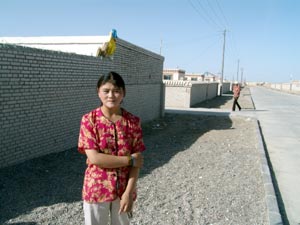| Tools: Save | Print | E-mail | Most Read |
| Qinghai-Tibet Line: An Instrument of Change |
| Adjust font size: |
Whether northbound or southbound, the Qinghai-Tibet Railway has changed the lifestyles of those who use it, witnessing a daily intake of around 4,000 passengers since its maiden voyage on July 1. Xining, capital city of Qinghai Province, is the starting point of the railway's first section, inaugurated in 1984.
Zhang saw his earnings soar to above 4,000 yuan (US$501.9) this summer from around 3,000 yuan (US$376.4) previously. His wife, Ms. Zhao, running a little handicraft souvenirs shop in downtown Xining, also saw a 10 percent hike in her July income. "We are planning to open another chain store for her next year and she could be a 'big boss' then," Zhang smiled. With more passersby coming to Xining, the province received 1.63 million tourists in July, up 34 percent from 2005, who provided 818 million yuan (US$102.6 million) of revenue, up 30 percent on the same period last year, according to Li Jincheng, vice governor of Qinghai. "Qinghai features many unique scenic attractions such as the Qinghai Lake, the Sanjiangyuan area (containing the Yellow, Lancang and Yangtze river springs), the Ta'er Monastery as well as the Hoh Xil nature reserve. The railway has inter-connected them with Tibet, Gansu and other tourism routes for better development," Li noted. However, halfway, the line has a different scene. Unlike Xining, Golmud, the starting point of the railway's second section, has gradually lost its appeal. Over the last half-century, the city, formerly a military transportation base, used to be the main entrance to Tibet, the only land route across the Qinghai-Tibet Plateau by which materials and goods were carried to Lhasa. Ma Yun, 27, from the Hui minority, moved from his hometown Tianshui in Gansu Province to Golmud with his wife three years ago, and began making shish kebabs on the Kunlun road. "What does the line bring to me? Just take a look: so many people have disappeared," Ma said, tapping his fingers on the stand. It used to be a busy place in the evening but now all the construction workers have gone and most travelers are heading for Tibet, Ma said. "We usually started business at 7 PM, finishing at midnight but now we have to work until 5 AM to live," said Ma's wife, 25. The opening of the railway resulted in a halt of the flow of people and goods into Golmud. From now on, 75 percent of goods coming in and out of Tibet will be transported by train, driving down highway freight transportation down by 80 percent. According to Lamao Jiancuo, deputy secretary of the Golmud municipal Party committee, this is due to the cheaper value of railway transportation (0.12 yuan per ton compared with 0.5 yuan by road.) The regional government is making efforts to turn the ex-transfer town into a goods distribution and supply center. To Xie Kangmin, general manager of Qinghai Salt Lake Industrial Group, China's largest producer of potassium chloride fertilizer, the opening of the railway is bitter-sweet. "The construction of the multiple track and the electrization of the railway have led to the slowing down of potash fertilizer transportation. However, I am confident for the future since next year, the line's distribution capacity should be dramatically increased," Xie said. In the suburbs of Golmud live a group of Tibetans who were herdsmen in the Tanggula Mountain Village before the railway line passed their field. Gengga Lanjie, 53, and his wife were one of 128 families transferred from the 4,300m-mountain area to Golmud in 2004. "The government gave us 40,000 yuan (US$5,019.2) as a construction subsidy in the beginning with 6,000 yuan (US$752.9) monthly food subsidy for five years," he said. Gengga has three children: one son and two daughters. All of them still live in the Tanggula Mountain Village, earning 5,000 yuan (US$627.4) apiece by breeding yaks and sheep. "They usually come to see us at the end of the year, a journey taking four to five hours. The income here is almost the same as on the mountain but the quality of life is much higher here," he said.
The residential zone for immigrants According to Qian Huasang, deputy secretary of the village's Party committee, the government built the residential zone specially for immigrants with each family sharing a 300 sq.m courtyard and 56 sq.m of living space. In addition to being construction workers in the city, the ex-herdsmen could also receive free training before securing jobs in the nearby Tibetan carpet factory to be opened later this year. In Tibet, many herdsmen also saw their lifestyle experiencing big changes due to the railroad. Cidan Duoji, a 37-year-old Tibetan in Dangxiong Prefecture, used to breed 98 yaks and over 50 sheep, earning a yearly 60,000 yuan (US$7,528.8) from his trade. In 2003, the Qinghai-Tibet Railway construction gave him a new money-making idea: sending sand and stone for the railroad project.
Cidan Duoji shows his water jug made in Nepal "Now I have my own car and company. Apart from the stockbreeding income, I am capable of earning 160,000 yuan (US$20,076.8) each year by sending sand to the construction sites. Since I started this business, the demand for these raw materials has risen by 80 percent," he said. According to the Tibet Tourism Bureau, some 374,000 Chinese and 16,700 foreigners visited the region last month, generating 4.35 million yuan (US$545,721.7) of revenue, up 43.7 percent on 2005. More people like Cidan Duoji are encouraged to engage in the transportation and service sectors along the track, as part of a government attempt to improve the lives of the herdsmen and local Tibetans. With the multiple tracks to be opened next year, more opportunities are waiting ahead for the highland people. (China.org.cn by staff reporter Li Xiao, August 28, 2006) |
| Tools: Save | Print | E-mail | Most Read |
 |
| Related Stories |
| Product Directory China Search |
Country Search Hot Buys |


